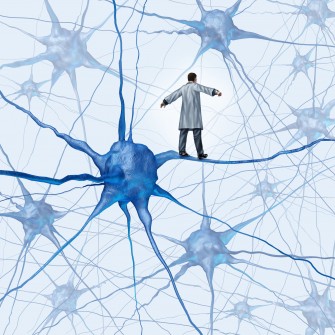Chronic Back Pain May Shrink the Brain
 Apkarian AV, Sosa Y, Sonty S, et al. Chronic back pain is associated with decreased prefrontal and thalamic gray matter density. The Journal of Neuroscience, Nov. 17, 2004 24(46):10410-10475.
Apkarian AV, Sosa Y, Sonty S, et al. Chronic back pain is associated with decreased prefrontal and thalamic gray matter density. The Journal of Neuroscience, Nov. 17, 2004 24(46):10410-10475.
This recent study has revealed that people who suffer from chronic back pain for one year may experience a reduction in the brain’s gray matter equivalent to the amount lost by the average person in 10 to 20 years of normal aging. The study is believed to be the first of its kind to show brain morphometric abnormalities in chronic pain. Investigators compared 26 patients with CBP (Chronic Back Pain) with 26 matched normal volunteers. The CBP patients experienced unrelenting pain for one year, “primarily localized to the lumbosacral region including buttocks and thighs, with or without pain radiating to the leg.” Of those with CBP, 55 percent had musculoskeletal diagnoses, 20 percent had pure radiculopathy, and 26 percent had a combination of musculoskeletal and radiculopathic pain. CBP patients were divided into neuropathic and non-neuropathic subtypes, with neuropathic patients experiencing significant radiculopathy, with or without the presence of musculoskeletal pain. The normal decrease in neocortical gray matter volume was found to be 2.8 cm (0.5%) per year in both groups. After adjusting for age and gender factors, the investigators found that the resultant gray matter volume loss was 663 ± 27 cm in the control subjects and 590 ± 28 cm in the CBP patients, reflecting an 11 percent decrease in gray matter volume for those with CBP. CBP patients with sciatica had the largest decrease in gray matter. In addition, the more years someone had chronic back pain, the more loss of gray matter they suffered. The authors found that the “mean gray matter volume was not different between neuropathic (nuCBP) and non-neuropathic (non-nuCBP) subtypes.” From their findings, the authors arrived at several conclusions: “The role of the brain in chronic pain conditions remains speculative. Our results imply that chronic back pain (CBP) is accompanied by brain atrophy and suggest that the pathophysiology of chronic pain includes thalamocortical processes. “Our studies show that CBP (sustained for six months) is accompanied by abnormal brain chemistry, mainly a reduction in the N-acetyl-aspartate-creatine ratio in the prefrontal cortex, implying neuronal loss or dysfunction in this region and reduced cognitive abilities on a task that implies abnormal prefrontal processing. “Our results demonstrate regionally specific reduced gray matter in patients with CBP. At the whole-brain level, this reduction is related to pain duration, regionally depends on multiple pain related characteristics, and is more severe in the neuropathic sub-type. “Given that normal whole-brain gray matter atrophy is 0.5% per year of aging and that atrophy caused by CBP is 5-11%, the magnitude of brain gray matter atrophy caused by CBP is equivalent to 10-20 years of aging. However, this analogy only holds for the overall magnitude, because the regional specificity of atrophy in CBP is distinct from that seen with aging.” Click here to read the article at the National Library of Medicine (PubMed)